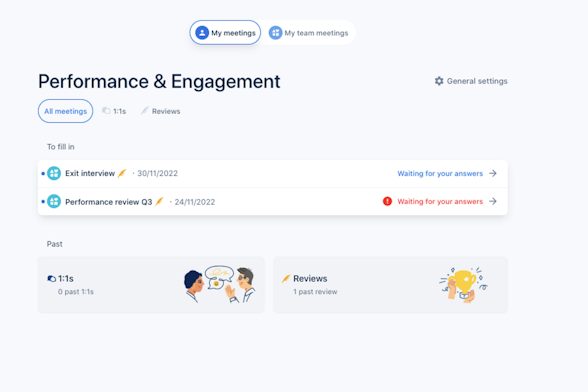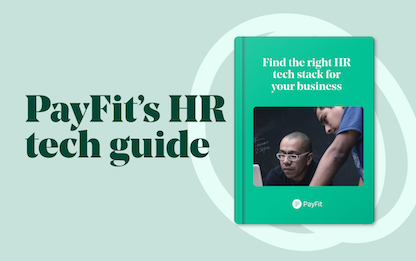- Blog
- |People management
- >Employee wellbeing
- >employee performance reviews
What Makes for Great Employee Performance Reviews?


Great employee performance reviews (or evaluations) can be the difference between your team simply getting by, or reaching new heights both individually and collectively. An effective review process helps to foster trust and transparency between managers and team members, to identify what’s working well and not so well, and to identify opportunities for growth & development. But there are many other benefits of employee performance reviews to speak of, which we’ll go into below.
Here, we’ll focus on some practical advice for UK businesses on conducting great employee performance evaluations. We’ll look at what managers should be assessing, how performance can be effectively measured, best practice guidelines to follow, plus the role that software can play in facilitating a great performance review process.
What is an employee performance review?
Also known as an appraisal, evaluation or annual review, an employee performance review is a formal assessment of an employee’s work across a set period - often quarterly or annually. As part of the performance review process, UK managers will ask employees to assess their overall performance, evaluate strengths and weaknesses and then discuss these together with the purpose of providing honest feedback and setting goals for the time ahead. Managers will usually provide a performance review template in Excel form to help capture all of these elements, but software can do this too (more on this later).
The process of evaluating performance should be a regular thing, and not necessarily restricted to the formal employee performance evaluation session. High performing UK teams are characterised by regular 1-2-1 check-ins, together with a culture of open and honest feedback. Some organisations have eliminated formal performance evaluations altogether, although they are recommended for mid to long term goal setting.
What are the benefits of a performance review?
It’s all too easy, particularly in today’s at-home led world of work, to keep ticking along without much interaction between the manager and employee. So it’s even more important, when face-to-face time might be a little less than it used to be, that the temperature is taken regularly from both sides.
The benefits of employee performance reviews will be felt both by the individual in question and the wider team. Employees gain a better understanding of what they’re doing well, as well as where they could improve. Managers can get feedback from employees to become the best leaders they can be, as well as communicate expectations to their team.
Some of the broad benefits of a performance evaluation are as follows.
Personal growth
Employee performance evaluations ultimately help staff to grow in both their roles and careers. They help provide the roadmap for that growth, and identify what needs to be done to get the employee where they want to be. And the same can be said for managers too, as the process of two-way feedback will contribute to their improvement as well.
Performance
By identifying what is working well, and not so well, employee performance reviews can help to drive up the output (not to mention wellbeing) of both reviewer and reviewee, as well as the team as a whole. And if aligned to elements such as pay rises and bonuses, then the performance review process helps to provide an incentive for improved performance.
Engagement
Being open and transparent helps improve engagement, especially if employees are shown just how much their actions can contribute to the company’s performance. Frequent check-ins show team members that managers care about them and are willing to take time to advise on how to improve and grow.
Training needs
Identifying what employees need in order to grow helps determine what additional training may be required. This may take the form of formal courses, or just the level of advice and support provided to the team by managers.
Expectation setting
One of the goals of employee performance reviews is to agree on what is expected of one another. And by setting clear expectations, the employee will know exactly what is needed to get to where they want to be, and what the consequences might be for falling short.
Bond strengthening
One of the unsung benefits of employee performance evaluations is how they strengthen bonds between employer and employee. The degree of transparency that these reviews demand helps to foster a culture of openness and trust, key fundamentals for a strong working relationship. But it’s important that any constructive feedback is exactly that, and that it’s done from a place of care, of wanting to help the other grow and improve.
Holding managers accountable
Employee performance evaluations should be a dialogue, not monologue. Part of this is creating a forum in which the employee can provide open feedback to their manager, to help them become the best managers they can be. This in turn will help the employee grow further still. Managers should be accountable for their team’s success, and the performance review process helps to facilitate this.

What should an employee performance evaluation be assessing?
Across industries and roles, employee performance evaluations tend to follow a fairly set structure in terms of how performance is assessed. If, as a UK manager or HR leader, you’re assessing the following skills, then you should be covering all bases.
Quality of work (on tasks dictated by the job description)
Problem solving
Collaboration and teamwork
Levels of attendance, punctuality and reliability
Whether preset goals and objectives have been met
Communication
In addition to these broad assessment categories, the employee performance review process should also look to assess position-specific output, and how work is contributing towards the role, team and wider company.
How should employee performance be measured?
There are several different ways of measuring an employee’s performance. The most common involve listing out the above assessment criteria, as well as goals and objectives, and asking the employee to assign a progress / achievement score to each. The manager will then add their own score or comments, and these will be discussed in the performance review itself.
The score format is entirely up to you (and will be dictated by the performance review module you may be using), but you could assign a percentage to each objective (along with statuses such as ‘on track’, ‘off track’ and ‘completed’), and a number out of 5 for the assessment criteria. It could be valuable for the performance review process to ask for written descriptions for each such as ‘excellent’, ‘good’, ‘average’, ‘poor’ etc., or even to use a colour coded grading system.
When evaluating performance, identify areas that require attention and agree on the steps needed to improve them.

What are best practices for the employee performance review process?
How you conduct your performance evaluations will be unique to your particular organisation, team and the individual in question. But there are a few best practice guidelines to follow to help ensure you’re both getting the maximum benefit from the process.
Don’t limit feedback to just the formal review
Instil a culture of open and honest feedback across your organisation. This should be one of the core behaviours or values that comes from the HR team. Practise radical honesty so that everybody in the team is holding one another accountable, and if something isn’t quite right, it’s discussed and improved upon quickly.
Honesty is the best policy
Feedback should always come from a place of care, and be constructive. Frame any employee performance review feedback around wanting to help the individual improve and grow. Managers should be explicit about what they expect, otherwise you’ll keep going round in circles and likely repeat the same feedback during the next formal evaluation cycle.
Face to face is best
We get it - UK teams work from home a lot nowadays. But for something as momentous as a formal performance review session, you’ll get so much more out of it from a perspective of ease of communication and transparency if you meet up in person.
It doesn’t have to be at the office - indeed, reviews might be better being conducted in a coffee shop, bar or restaurant, where you can both relax and experience a comfortable atmosphere.
Use clear examples where possible
Being able to provide examples of good performance, or areas to work on, is a central tenet of employee performance evaluations. Not being able to do so can lead to trust being eroded between manager and employee (if you’ve got nothing to back up your point of view, can it be trusted?). A lack of clarity or understanding where something hasn’t gone to plan will just mean that you’re destined to have the same behaviours repeated.
Always end the conversation on a positive note
This helps for creating that strengthened bond and ensuring that feedback will be actioned upon. Equipping team members with a sense of optimism will help them to picture that it can be done, and improve the chances of it happening!

How can software facilitate a great employee performance review process?
Great employee performance review software can really amplify the effectiveness of the whole process. The whole point of software is to simplify the steps involved, improve collaboration and help promote the regular giving and receiving of feedback from an easily accessible platform.
Rather than a generic Excel spreadsheet, employee performance review software is designed for exactly what it says on tin, so will be geared towards teams getting the maximum benefit from evaluations.
You can find out more about how software helps HR teams manage performance more effectively, as well as a whole host of other things including payroll, annual leave, expenses and more, by booking a demo with a member of the PayFit team.


UK Expenses Management - A Guide For Employers

Overtime Pay Rates & Laws in the UK

The 2024 UK National Living Wage - An Employer’s Guide

The Cost Of Recruitment In The UK - What You Might Not Know

UK National Insurance Changes for January 2024

